Intelligent Systems for Analytics: Socially Aware Computing Report
VerifiedAdded on 2022/11/22
|11
|2423
|255
Report
AI Summary
This report provides a comprehensive overview of intelligent systems for socially aware computing, a rapidly evolving field that leverages technology to understand and enhance human interactions. It explores the core concepts of socially aware computing, including the use of various sensors and data sources like smartphones to gather information about individual behavior and social contexts. The report delves into the practical applications of this technology, particularly focusing on how smartphones are used to improve social interactions, understand social relationships through mobile phone data analysis, and implement semantic representations of collected data. It examines the origin of socially aware computing, the processing of multimodal data, and the use of semantic representation. Furthermore, the report discusses real-world applications such as enhancing social interaction with smartphones, and the development of social relationships using mobile phone data. The report concludes by emphasizing the importance of balancing data utility with user privacy and the potential for future applications in areas like healthcare and urban planning. The report is based on the assignment brief for MITS5509 Intelligent Systems for Analytics, highlighting the importance of research and report writing skills.
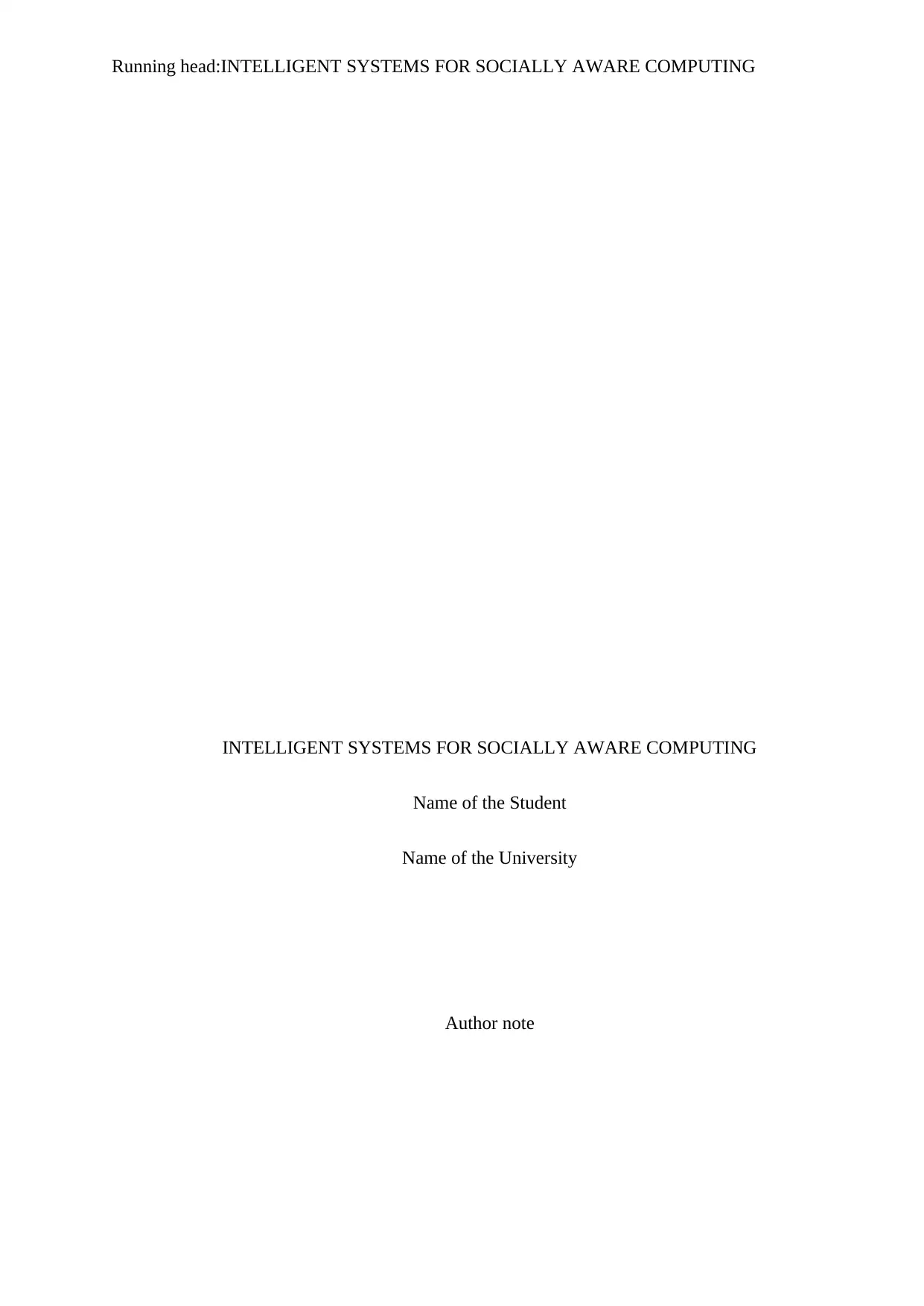
Running head:INTELLIGENT SYSTEMS FOR SOCIALLY AWARE COMPUTING
INTELLIGENT SYSTEMS FOR SOCIALLY AWARE COMPUTING
Name of the Student
Name of the University
Author note
INTELLIGENT SYSTEMS FOR SOCIALLY AWARE COMPUTING
Name of the Student
Name of the University
Author note
Paraphrase This Document
Need a fresh take? Get an instant paraphrase of this document with our AI Paraphraser
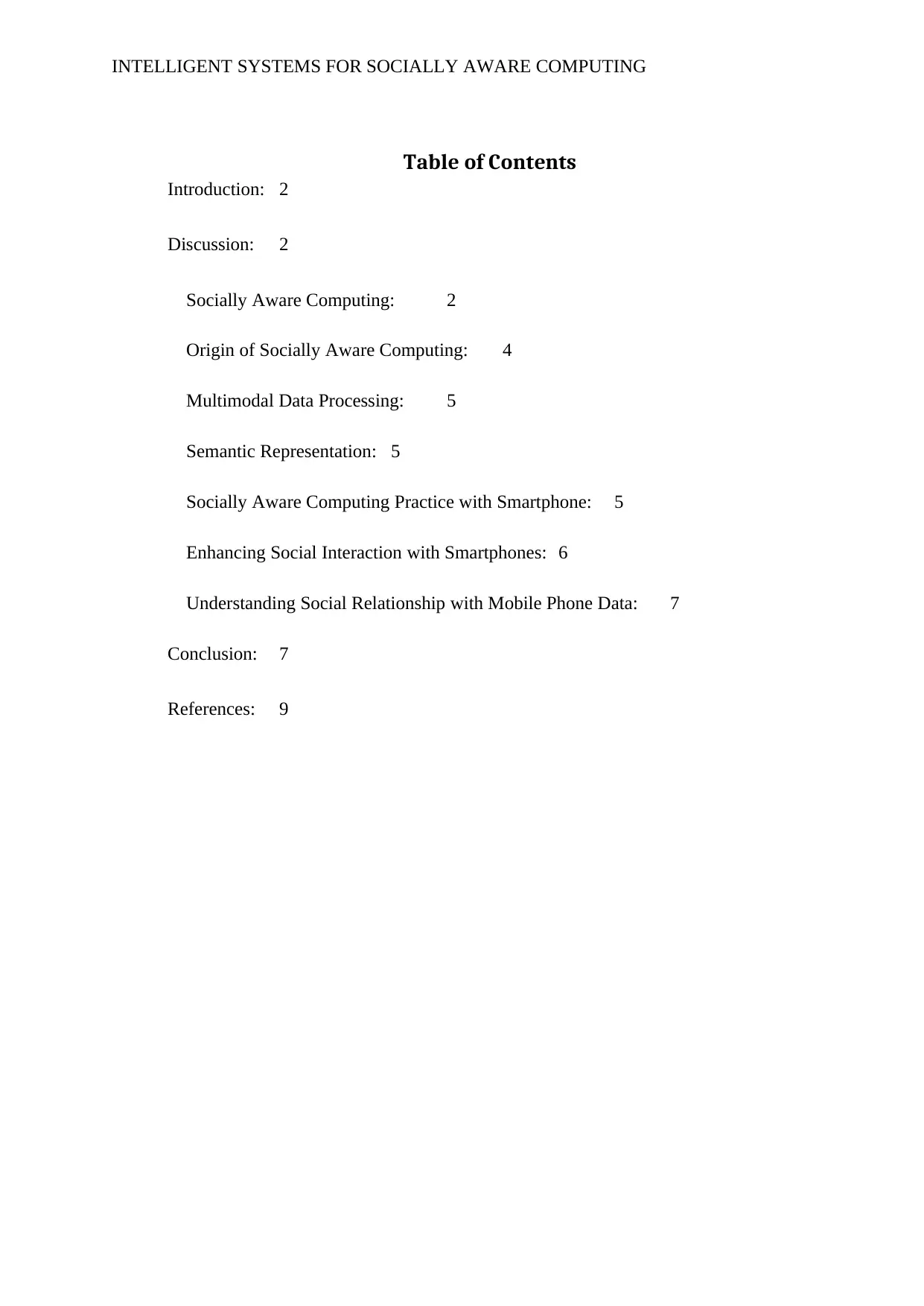
INTELLIGENT SYSTEMS FOR SOCIALLY AWARE COMPUTING
Table of Contents
Introduction: 2
Discussion: 2
Socially Aware Computing: 2
Origin of Socially Aware Computing: 4
Multimodal Data Processing: 5
Semantic Representation: 5
Socially Aware Computing Practice with Smartphone: 5
Enhancing Social Interaction with Smartphones: 6
Understanding Social Relationship with Mobile Phone Data: 7
Conclusion: 7
References: 9
Table of Contents
Introduction: 2
Discussion: 2
Socially Aware Computing: 2
Origin of Socially Aware Computing: 4
Multimodal Data Processing: 5
Semantic Representation: 5
Socially Aware Computing Practice with Smartphone: 5
Enhancing Social Interaction with Smartphones: 6
Understanding Social Relationship with Mobile Phone Data: 7
Conclusion: 7
References: 9
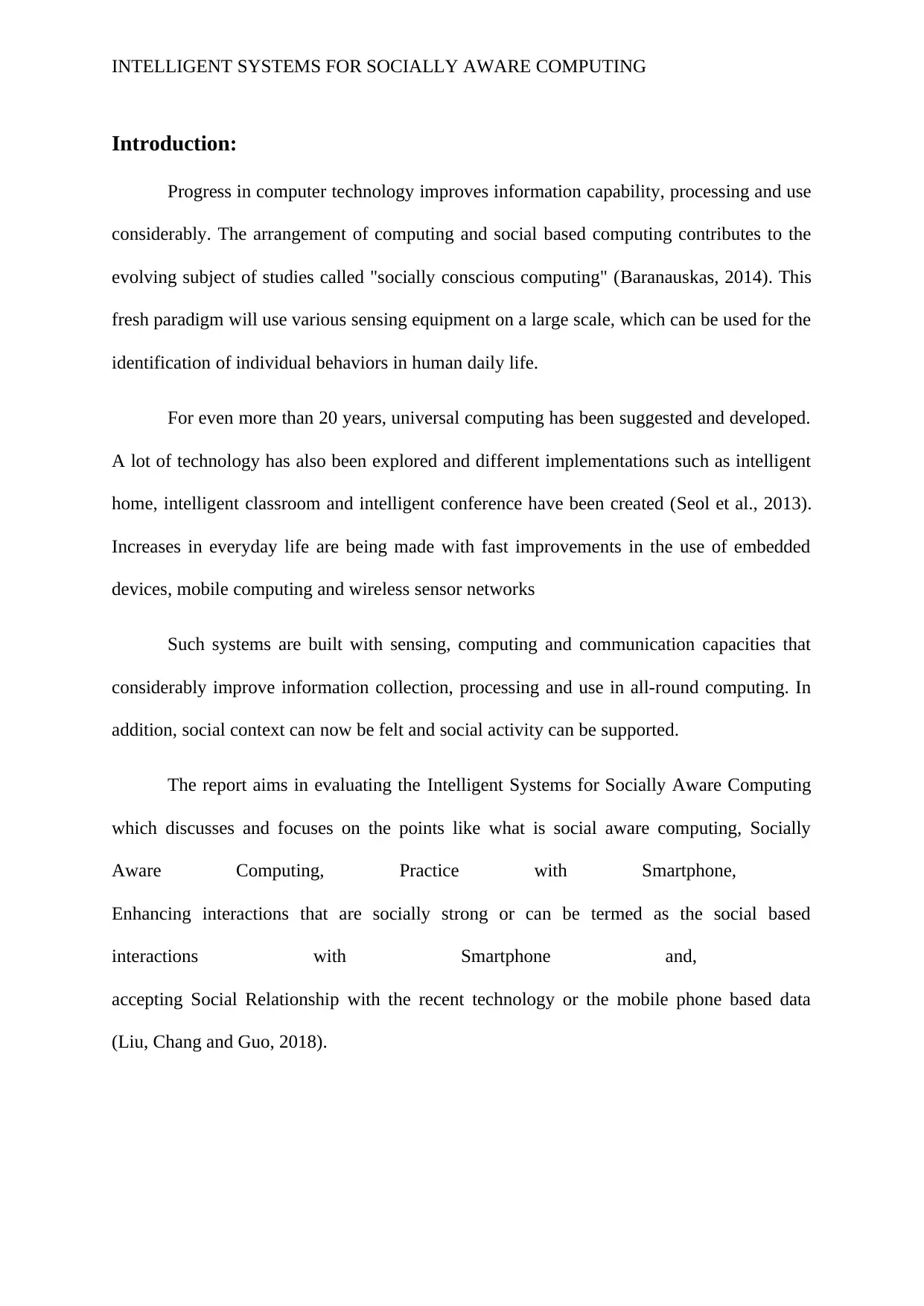
INTELLIGENT SYSTEMS FOR SOCIALLY AWARE COMPUTING
Introduction:
Progress in computer technology improves information capability, processing and use
considerably. The arrangement of computing and social based computing contributes to the
evolving subject of studies called "socially conscious computing" (Baranauskas, 2014). This
fresh paradigm will use various sensing equipment on a large scale, which can be used for the
identification of individual behaviors in human daily life.
For even more than 20 years, universal computing has been suggested and developed.
A lot of technology has also been explored and different implementations such as intelligent
home, intelligent classroom and intelligent conference have been created (Seol et al., 2013).
Increases in everyday life are being made with fast improvements in the use of embedded
devices, mobile computing and wireless sensor networks
Such systems are built with sensing, computing and communication capacities that
considerably improve information collection, processing and use in all-round computing. In
addition, social context can now be felt and social activity can be supported.
The report aims in evaluating the Intelligent Systems for Socially Aware Computing
which discusses and focuses on the points like what is social aware computing, Socially
Aware Computing, Practice with Smartphone,
Enhancing interactions that are socially strong or can be termed as the social based
interactions with Smartphone and,
accepting Social Relationship with the recent technology or the mobile phone based data
(Liu, Chang and Guo, 2018).
Introduction:
Progress in computer technology improves information capability, processing and use
considerably. The arrangement of computing and social based computing contributes to the
evolving subject of studies called "socially conscious computing" (Baranauskas, 2014). This
fresh paradigm will use various sensing equipment on a large scale, which can be used for the
identification of individual behaviors in human daily life.
For even more than 20 years, universal computing has been suggested and developed.
A lot of technology has also been explored and different implementations such as intelligent
home, intelligent classroom and intelligent conference have been created (Seol et al., 2013).
Increases in everyday life are being made with fast improvements in the use of embedded
devices, mobile computing and wireless sensor networks
Such systems are built with sensing, computing and communication capacities that
considerably improve information collection, processing and use in all-round computing. In
addition, social context can now be felt and social activity can be supported.
The report aims in evaluating the Intelligent Systems for Socially Aware Computing
which discusses and focuses on the points like what is social aware computing, Socially
Aware Computing, Practice with Smartphone,
Enhancing interactions that are socially strong or can be termed as the social based
interactions with Smartphone and,
accepting Social Relationship with the recent technology or the mobile phone based data
(Liu, Chang and Guo, 2018).
⊘ This is a preview!⊘
Do you want full access?
Subscribe today to unlock all pages.

Trusted by 1+ million students worldwide
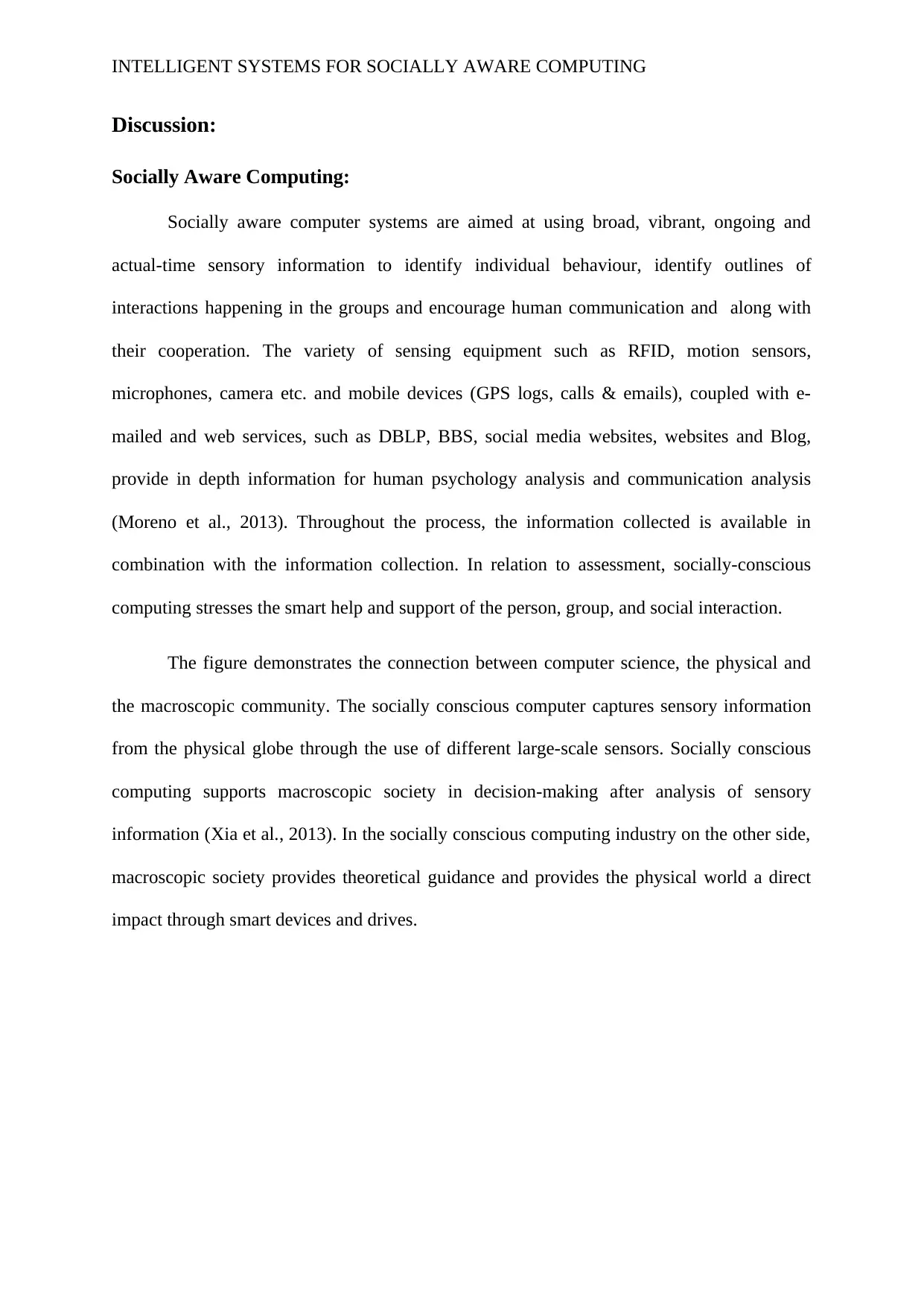
INTELLIGENT SYSTEMS FOR SOCIALLY AWARE COMPUTING
Discussion:
Socially Aware Computing:
Socially aware computer systems are aimed at using broad, vibrant, ongoing and
actual-time sensory information to identify individual behaviour, identify outlines of
interactions happening in the groups and encourage human communication and along with
their cooperation. The variety of sensing equipment such as RFID, motion sensors,
microphones, camera etc. and mobile devices (GPS logs, calls & emails), coupled with e-
mailed and web services, such as DBLP, BBS, social media websites, websites and Blog,
provide in depth information for human psychology analysis and communication analysis
(Moreno et al., 2013). Throughout the process, the information collected is available in
combination with the information collection. In relation to assessment, socially-conscious
computing stresses the smart help and support of the person, group, and social interaction.
The figure demonstrates the connection between computer science, the physical and
the macroscopic community. The socially conscious computer captures sensory information
from the physical globe through the use of different large-scale sensors. Socially conscious
computing supports macroscopic society in decision-making after analysis of sensory
information (Xia et al., 2013). In the socially conscious computing industry on the other side,
macroscopic society provides theoretical guidance and provides the physical world a direct
impact through smart devices and drives.
Discussion:
Socially Aware Computing:
Socially aware computer systems are aimed at using broad, vibrant, ongoing and
actual-time sensory information to identify individual behaviour, identify outlines of
interactions happening in the groups and encourage human communication and along with
their cooperation. The variety of sensing equipment such as RFID, motion sensors,
microphones, camera etc. and mobile devices (GPS logs, calls & emails), coupled with e-
mailed and web services, such as DBLP, BBS, social media websites, websites and Blog,
provide in depth information for human psychology analysis and communication analysis
(Moreno et al., 2013). Throughout the process, the information collected is available in
combination with the information collection. In relation to assessment, socially-conscious
computing stresses the smart help and support of the person, group, and social interaction.
The figure demonstrates the connection between computer science, the physical and
the macroscopic community. The socially conscious computer captures sensory information
from the physical globe through the use of different large-scale sensors. Socially conscious
computing supports macroscopic society in decision-making after analysis of sensory
information (Xia et al., 2013). In the socially conscious computing industry on the other side,
macroscopic society provides theoretical guidance and provides the physical world a direct
impact through smart devices and drives.
Paraphrase This Document
Need a fresh take? Get an instant paraphrase of this document with our AI Paraphraser
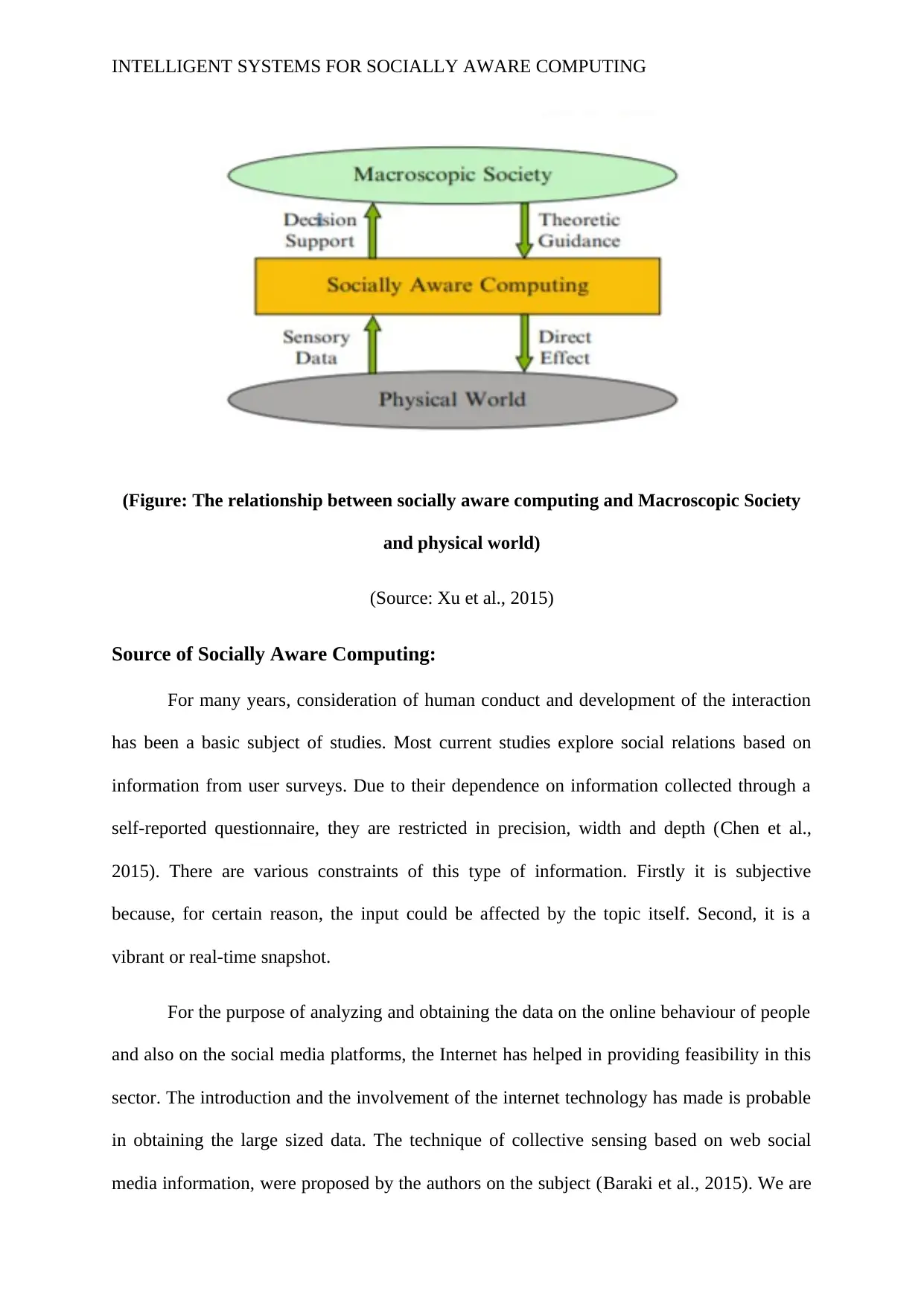
INTELLIGENT SYSTEMS FOR SOCIALLY AWARE COMPUTING
(Figure: The relationship between socially aware computing and Macroscopic Society
and physical world)
(Source: Xu et al., 2015)
Source of Socially Aware Computing:
For many years, consideration of human conduct and development of the interaction
has been a basic subject of studies. Most current studies explore social relations based on
information from user surveys. Due to their dependence on information collected through a
self-reported questionnaire, they are restricted in precision, width and depth (Chen et al.,
2015). There are various constraints of this type of information. Firstly it is subjective
because, for certain reason, the input could be affected by the topic itself. Second, it is a
vibrant or real-time snapshot.
For the purpose of analyzing and obtaining the data on the online behaviour of people
and also on the social media platforms, the Internet has helped in providing feasibility in this
sector. The introduction and the involvement of the internet technology has made is probable
in obtaining the large sized data. The technique of collective sensing based on web social
media information, were proposed by the authors on the subject (Baraki et al., 2015). We are
(Figure: The relationship between socially aware computing and Macroscopic Society
and physical world)
(Source: Xu et al., 2015)
Source of Socially Aware Computing:
For many years, consideration of human conduct and development of the interaction
has been a basic subject of studies. Most current studies explore social relations based on
information from user surveys. Due to their dependence on information collected through a
self-reported questionnaire, they are restricted in precision, width and depth (Chen et al.,
2015). There are various constraints of this type of information. Firstly it is subjective
because, for certain reason, the input could be affected by the topic itself. Second, it is a
vibrant or real-time snapshot.
For the purpose of analyzing and obtaining the data on the online behaviour of people
and also on the social media platforms, the Internet has helped in providing feasibility in this
sector. The introduction and the involvement of the internet technology has made is probable
in obtaining the large sized data. The technique of collective sensing based on web social
media information, were proposed by the authors on the subject (Baraki et al., 2015). We are
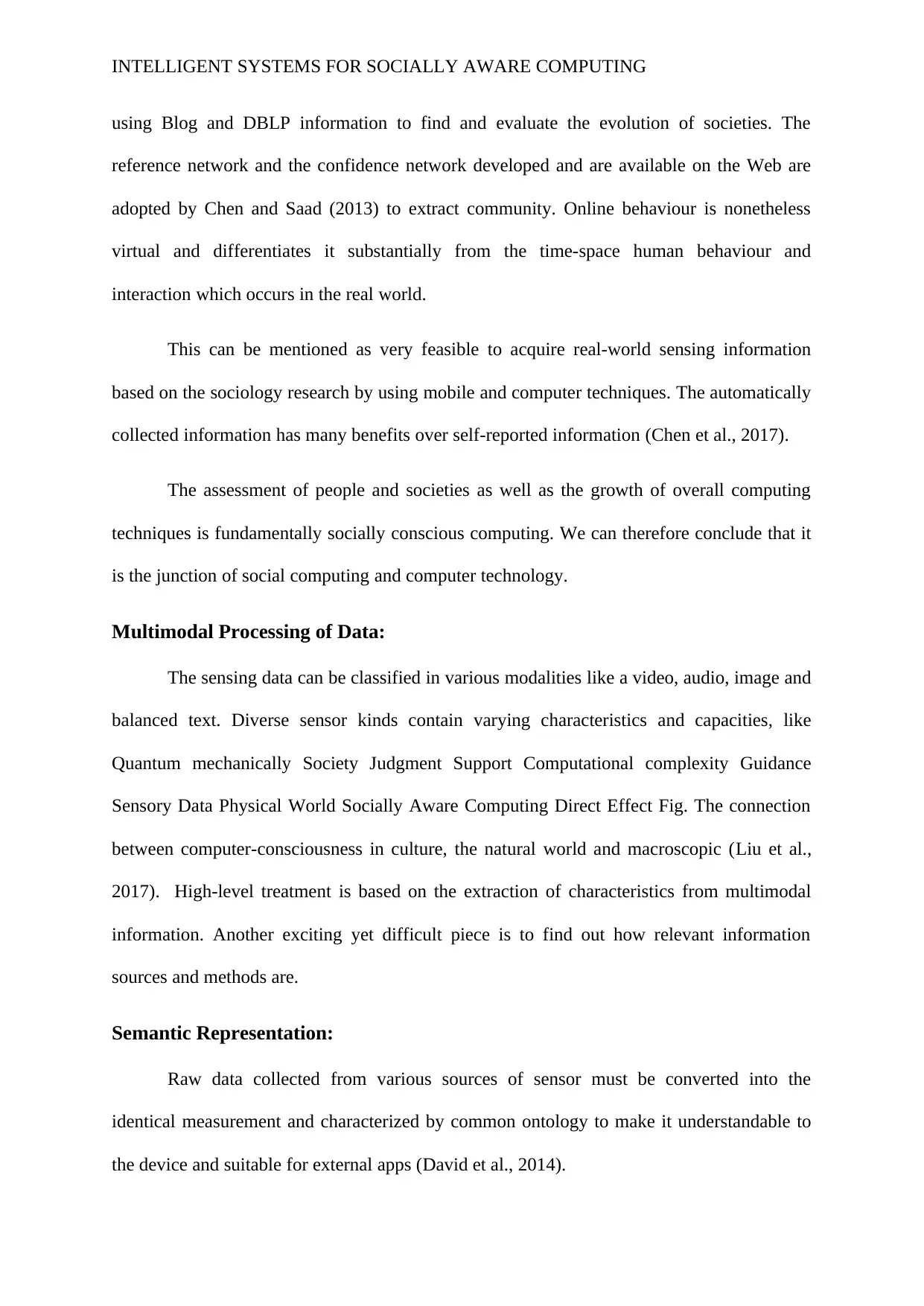
INTELLIGENT SYSTEMS FOR SOCIALLY AWARE COMPUTING
using Blog and DBLP information to find and evaluate the evolution of societies. The
reference network and the confidence network developed and are available on the Web are
adopted by Chen and Saad (2013) to extract community. Online behaviour is nonetheless
virtual and differentiates it substantially from the time-space human behaviour and
interaction which occurs in the real world.
This can be mentioned as very feasible to acquire real-world sensing information
based on the sociology research by using mobile and computer techniques. The automatically
collected information has many benefits over self-reported information (Chen et al., 2017).
The assessment of people and societies as well as the growth of overall computing
techniques is fundamentally socially conscious computing. We can therefore conclude that it
is the junction of social computing and computer technology.
Multimodal Processing of Data:
The sensing data can be classified in various modalities like a video, audio, image and
balanced text. Diverse sensor kinds contain varying characteristics and capacities, like
Quantum mechanically Society Judgment Support Computational complexity Guidance
Sensory Data Physical World Socially Aware Computing Direct Effect Fig. The connection
between computer-consciousness in culture, the natural world and macroscopic (Liu et al.,
2017). High-level treatment is based on the extraction of characteristics from multimodal
information. Another exciting yet difficult piece is to find out how relevant information
sources and methods are.
Semantic Representation:
Raw data collected from various sources of sensor must be converted into the
identical measurement and characterized by common ontology to make it understandable to
the device and suitable for external apps (David et al., 2014).
using Blog and DBLP information to find and evaluate the evolution of societies. The
reference network and the confidence network developed and are available on the Web are
adopted by Chen and Saad (2013) to extract community. Online behaviour is nonetheless
virtual and differentiates it substantially from the time-space human behaviour and
interaction which occurs in the real world.
This can be mentioned as very feasible to acquire real-world sensing information
based on the sociology research by using mobile and computer techniques. The automatically
collected information has many benefits over self-reported information (Chen et al., 2017).
The assessment of people and societies as well as the growth of overall computing
techniques is fundamentally socially conscious computing. We can therefore conclude that it
is the junction of social computing and computer technology.
Multimodal Processing of Data:
The sensing data can be classified in various modalities like a video, audio, image and
balanced text. Diverse sensor kinds contain varying characteristics and capacities, like
Quantum mechanically Society Judgment Support Computational complexity Guidance
Sensory Data Physical World Socially Aware Computing Direct Effect Fig. The connection
between computer-consciousness in culture, the natural world and macroscopic (Liu et al.,
2017). High-level treatment is based on the extraction of characteristics from multimodal
information. Another exciting yet difficult piece is to find out how relevant information
sources and methods are.
Semantic Representation:
Raw data collected from various sources of sensor must be converted into the
identical measurement and characterized by common ontology to make it understandable to
the device and suitable for external apps (David et al., 2014).
⊘ This is a preview!⊘
Do you want full access?
Subscribe today to unlock all pages.

Trusted by 1+ million students worldwide
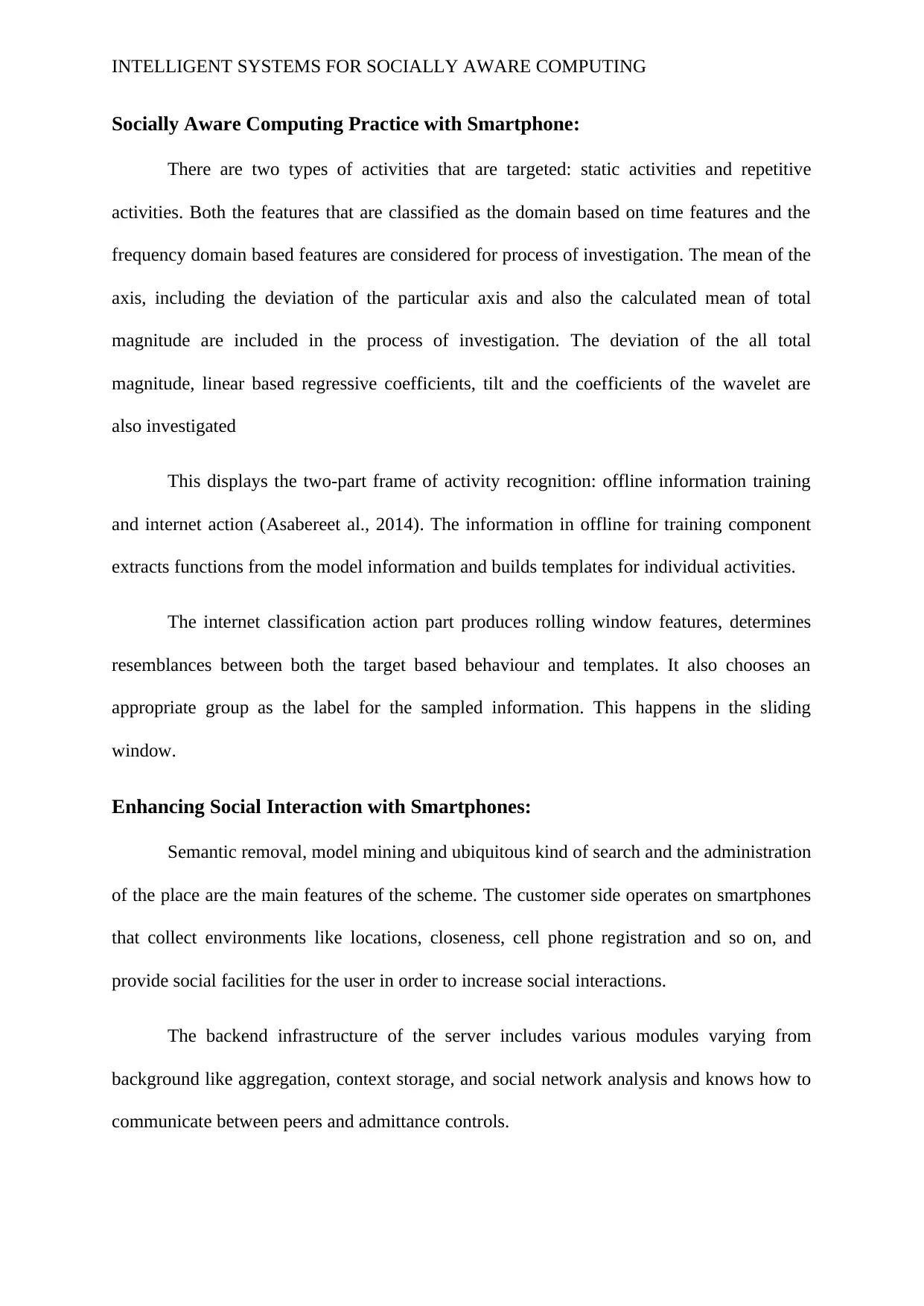
INTELLIGENT SYSTEMS FOR SOCIALLY AWARE COMPUTING
Socially Aware Computing Practice with Smartphone:
There are two types of activities that are targeted: static activities and repetitive
activities. Both the features that are classified as the domain based on time features and the
frequency domain based features are considered for process of investigation. The mean of the
axis, including the deviation of the particular axis and also the calculated mean of total
magnitude are included in the process of investigation. The deviation of the all total
magnitude, linear based regressive coefficients, tilt and the coefficients of the wavelet are
also investigated
This displays the two-part frame of activity recognition: offline information training
and internet action (Asabereet al., 2014). The information in offline for training component
extracts functions from the model information and builds templates for individual activities.
The internet classification action part produces rolling window features, determines
resemblances between both the target based behaviour and templates. It also chooses an
appropriate group as the label for the sampled information. This happens in the sliding
window.
Enhancing Social Interaction with Smartphones:
Semantic removal, model mining and ubiquitous kind of search and the administration
of the place are the main features of the scheme. The customer side operates on smartphones
that collect environments like locations, closeness, cell phone registration and so on, and
provide social facilities for the user in order to increase social interactions.
The backend infrastructure of the server includes various modules varying from
background like aggregation, context storage, and social network analysis and knows how to
communicate between peers and admittance controls.
Socially Aware Computing Practice with Smartphone:
There are two types of activities that are targeted: static activities and repetitive
activities. Both the features that are classified as the domain based on time features and the
frequency domain based features are considered for process of investigation. The mean of the
axis, including the deviation of the particular axis and also the calculated mean of total
magnitude are included in the process of investigation. The deviation of the all total
magnitude, linear based regressive coefficients, tilt and the coefficients of the wavelet are
also investigated
This displays the two-part frame of activity recognition: offline information training
and internet action (Asabereet al., 2014). The information in offline for training component
extracts functions from the model information and builds templates for individual activities.
The internet classification action part produces rolling window features, determines
resemblances between both the target based behaviour and templates. It also chooses an
appropriate group as the label for the sampled information. This happens in the sliding
window.
Enhancing Social Interaction with Smartphones:
Semantic removal, model mining and ubiquitous kind of search and the administration
of the place are the main features of the scheme. The customer side operates on smartphones
that collect environments like locations, closeness, cell phone registration and so on, and
provide social facilities for the user in order to increase social interactions.
The backend infrastructure of the server includes various modules varying from
background like aggregation, context storage, and social network analysis and knows how to
communicate between peers and admittance controls.
Paraphrase This Document
Need a fresh take? Get an instant paraphrase of this document with our AI Paraphraser
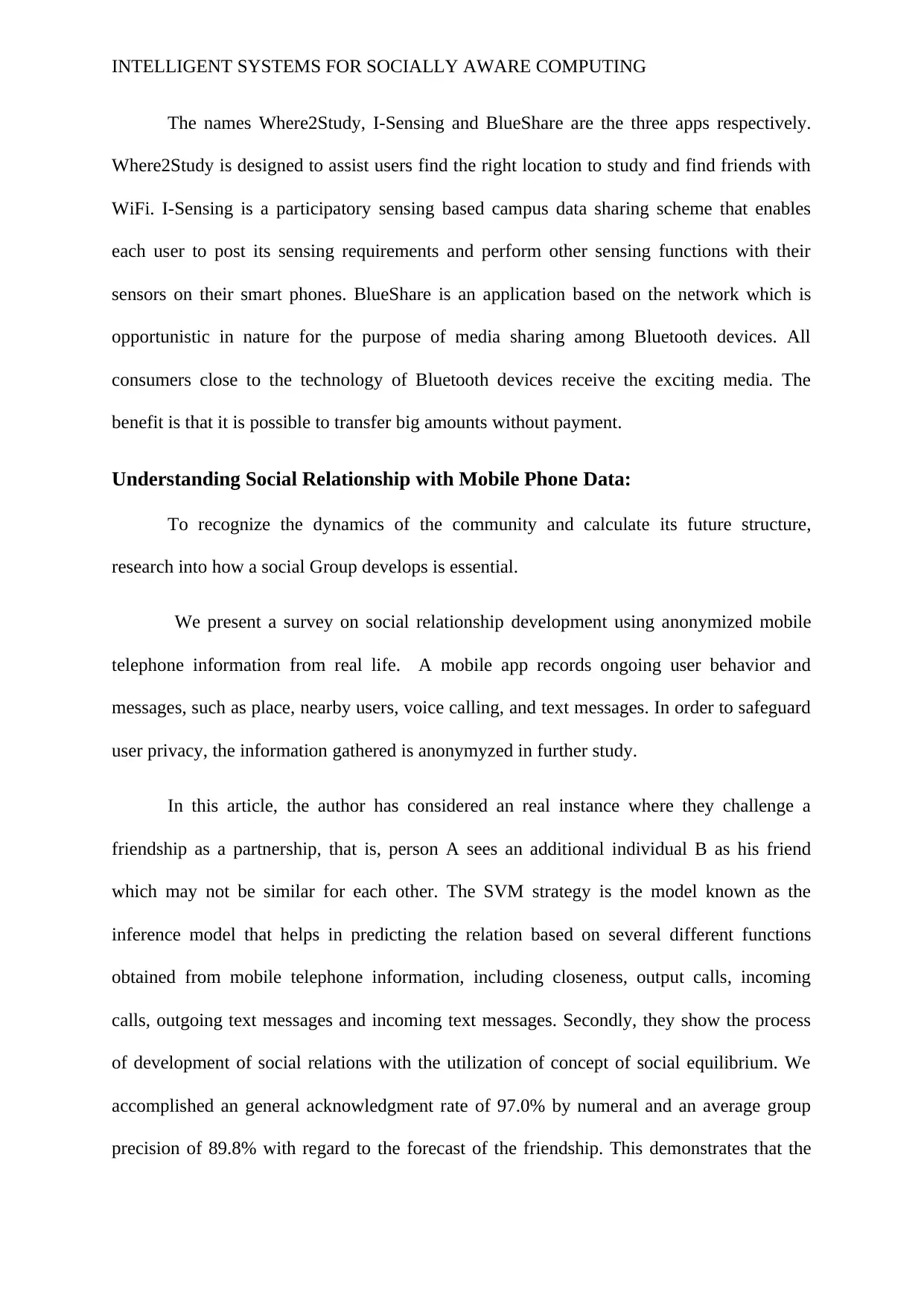
INTELLIGENT SYSTEMS FOR SOCIALLY AWARE COMPUTING
The names Where2Study, I-Sensing and BlueShare are the three apps respectively.
Where2Study is designed to assist users find the right location to study and find friends with
WiFi. I-Sensing is a participatory sensing based campus data sharing scheme that enables
each user to post its sensing requirements and perform other sensing functions with their
sensors on their smart phones. BlueShare is an application based on the network which is
opportunistic in nature for the purpose of media sharing among Bluetooth devices. All
consumers close to the technology of Bluetooth devices receive the exciting media. The
benefit is that it is possible to transfer big amounts without payment.
Understanding Social Relationship with Mobile Phone Data:
To recognize the dynamics of the community and calculate its future structure,
research into how a social Group develops is essential.
We present a survey on social relationship development using anonymized mobile
telephone information from real life. A mobile app records ongoing user behavior and
messages, such as place, nearby users, voice calling, and text messages. In order to safeguard
user privacy, the information gathered is anonymyzed in further study.
In this article, the author has considered an real instance where they challenge a
friendship as a partnership, that is, person A sees an additional individual B as his friend
which may not be similar for each other. The SVM strategy is the model known as the
inference model that helps in predicting the relation based on several different functions
obtained from mobile telephone information, including closeness, output calls, incoming
calls, outgoing text messages and incoming text messages. Secondly, they show the process
of development of social relations with the utilization of concept of social equilibrium. We
accomplished an general acknowledgment rate of 97.0% by numeral and an average group
precision of 89.8% with regard to the forecast of the friendship. This demonstrates that the
The names Where2Study, I-Sensing and BlueShare are the three apps respectively.
Where2Study is designed to assist users find the right location to study and find friends with
WiFi. I-Sensing is a participatory sensing based campus data sharing scheme that enables
each user to post its sensing requirements and perform other sensing functions with their
sensors on their smart phones. BlueShare is an application based on the network which is
opportunistic in nature for the purpose of media sharing among Bluetooth devices. All
consumers close to the technology of Bluetooth devices receive the exciting media. The
benefit is that it is possible to transfer big amounts without payment.
Understanding Social Relationship with Mobile Phone Data:
To recognize the dynamics of the community and calculate its future structure,
research into how a social Group develops is essential.
We present a survey on social relationship development using anonymized mobile
telephone information from real life. A mobile app records ongoing user behavior and
messages, such as place, nearby users, voice calling, and text messages. In order to safeguard
user privacy, the information gathered is anonymyzed in further study.
In this article, the author has considered an real instance where they challenge a
friendship as a partnership, that is, person A sees an additional individual B as his friend
which may not be similar for each other. The SVM strategy is the model known as the
inference model that helps in predicting the relation based on several different functions
obtained from mobile telephone information, including closeness, output calls, incoming
calls, outgoing text messages and incoming text messages. Secondly, they show the process
of development of social relations with the utilization of concept of social equilibrium. We
accomplished an general acknowledgment rate of 97.0% by numeral and an average group
precision of 89.8% with regard to the forecast of the friendship. This demonstrates that the
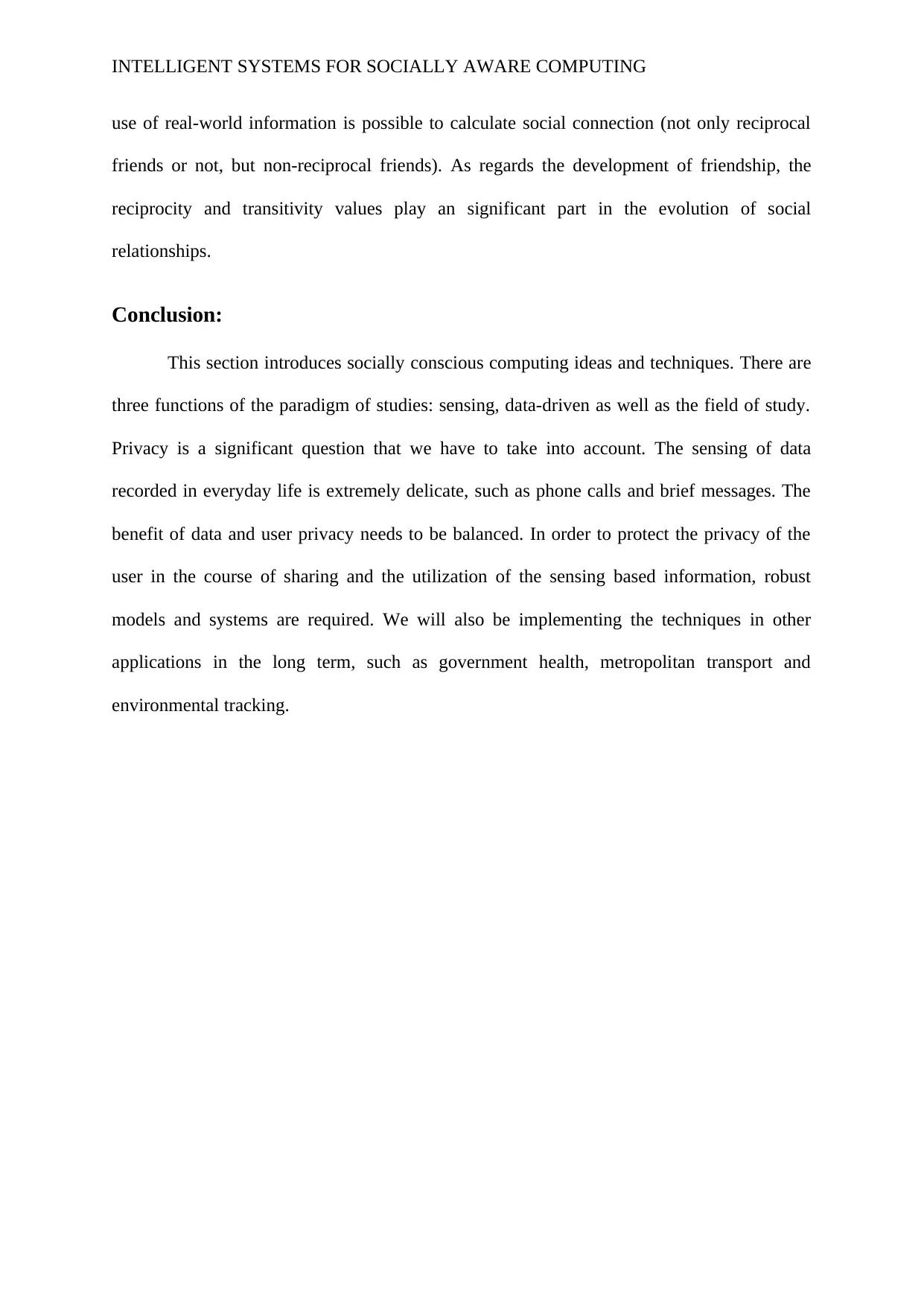
INTELLIGENT SYSTEMS FOR SOCIALLY AWARE COMPUTING
use of real-world information is possible to calculate social connection (not only reciprocal
friends or not, but non-reciprocal friends). As regards the development of friendship, the
reciprocity and transitivity values play an significant part in the evolution of social
relationships.
Conclusion:
This section introduces socially conscious computing ideas and techniques. There are
three functions of the paradigm of studies: sensing, data-driven as well as the field of study.
Privacy is a significant question that we have to take into account. The sensing of data
recorded in everyday life is extremely delicate, such as phone calls and brief messages. The
benefit of data and user privacy needs to be balanced. In order to protect the privacy of the
user in the course of sharing and the utilization of the sensing based information, robust
models and systems are required. We will also be implementing the techniques in other
applications in the long term, such as government health, metropolitan transport and
environmental tracking.
use of real-world information is possible to calculate social connection (not only reciprocal
friends or not, but non-reciprocal friends). As regards the development of friendship, the
reciprocity and transitivity values play an significant part in the evolution of social
relationships.
Conclusion:
This section introduces socially conscious computing ideas and techniques. There are
three functions of the paradigm of studies: sensing, data-driven as well as the field of study.
Privacy is a significant question that we have to take into account. The sensing of data
recorded in everyday life is extremely delicate, such as phone calls and brief messages. The
benefit of data and user privacy needs to be balanced. In order to protect the privacy of the
user in the course of sharing and the utilization of the sensing based information, robust
models and systems are required. We will also be implementing the techniques in other
applications in the long term, such as government health, metropolitan transport and
environmental tracking.
⊘ This is a preview!⊘
Do you want full access?
Subscribe today to unlock all pages.

Trusted by 1+ million students worldwide
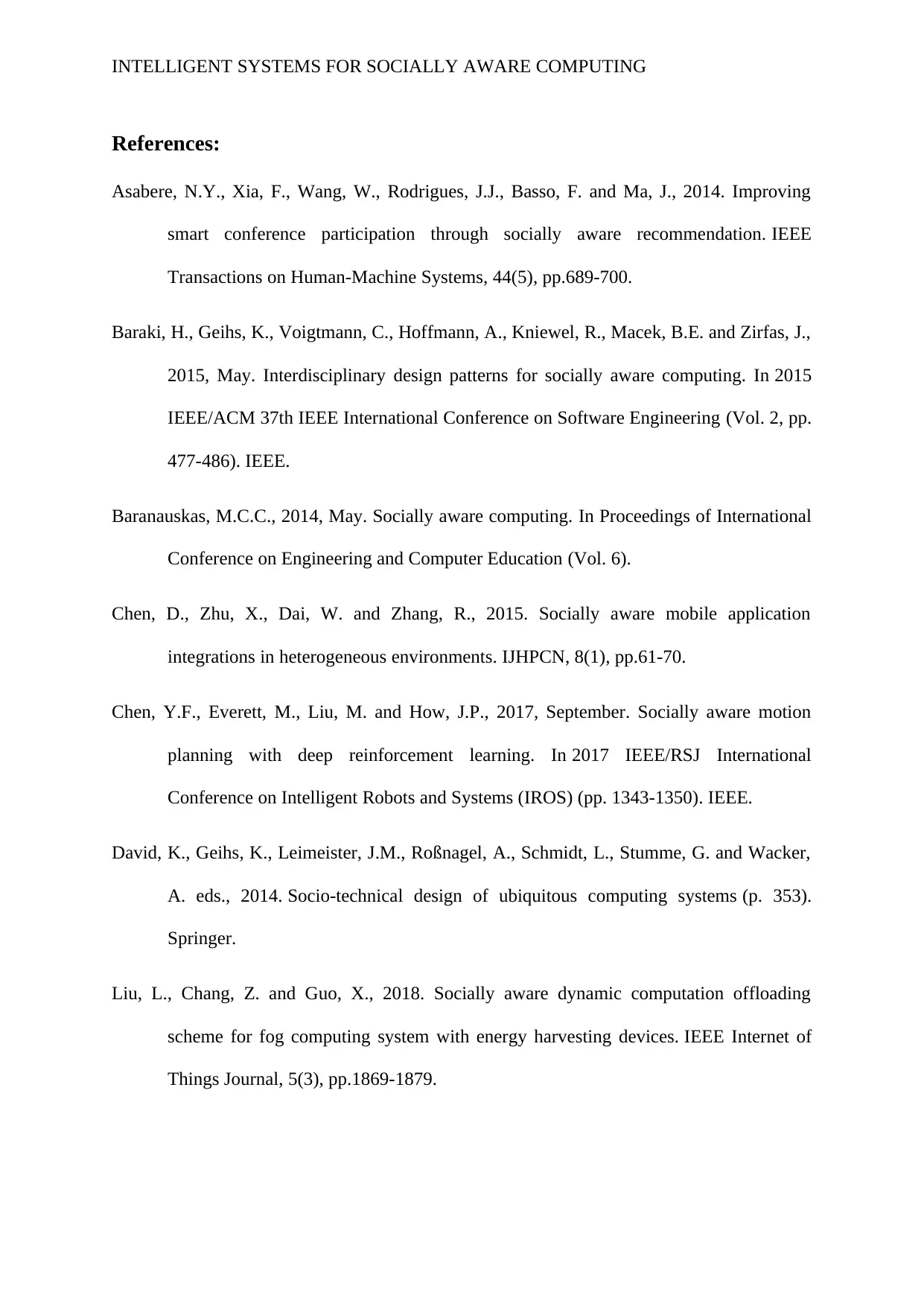
INTELLIGENT SYSTEMS FOR SOCIALLY AWARE COMPUTING
References:
Asabere, N.Y., Xia, F., Wang, W., Rodrigues, J.J., Basso, F. and Ma, J., 2014. Improving
smart conference participation through socially aware recommendation. IEEE
Transactions on Human-Machine Systems, 44(5), pp.689-700.
Baraki, H., Geihs, K., Voigtmann, C., Hoffmann, A., Kniewel, R., Macek, B.E. and Zirfas, J.,
2015, May. Interdisciplinary design patterns for socially aware computing. In 2015
IEEE/ACM 37th IEEE International Conference on Software Engineering (Vol. 2, pp.
477-486). IEEE.
Baranauskas, M.C.C., 2014, May. Socially aware computing. In Proceedings of International
Conference on Engineering and Computer Education (Vol. 6).
Chen, D., Zhu, X., Dai, W. and Zhang, R., 2015. Socially aware mobile application
integrations in heterogeneous environments. IJHPCN, 8(1), pp.61-70.
Chen, Y.F., Everett, M., Liu, M. and How, J.P., 2017, September. Socially aware motion
planning with deep reinforcement learning. In 2017 IEEE/RSJ International
Conference on Intelligent Robots and Systems (IROS) (pp. 1343-1350). IEEE.
David, K., Geihs, K., Leimeister, J.M., Roßnagel, A., Schmidt, L., Stumme, G. and Wacker,
A. eds., 2014. Socio-technical design of ubiquitous computing systems (p. 353).
Springer.
Liu, L., Chang, Z. and Guo, X., 2018. Socially aware dynamic computation offloading
scheme for fog computing system with energy harvesting devices. IEEE Internet of
Things Journal, 5(3), pp.1869-1879.
References:
Asabere, N.Y., Xia, F., Wang, W., Rodrigues, J.J., Basso, F. and Ma, J., 2014. Improving
smart conference participation through socially aware recommendation. IEEE
Transactions on Human-Machine Systems, 44(5), pp.689-700.
Baraki, H., Geihs, K., Voigtmann, C., Hoffmann, A., Kniewel, R., Macek, B.E. and Zirfas, J.,
2015, May. Interdisciplinary design patterns for socially aware computing. In 2015
IEEE/ACM 37th IEEE International Conference on Software Engineering (Vol. 2, pp.
477-486). IEEE.
Baranauskas, M.C.C., 2014, May. Socially aware computing. In Proceedings of International
Conference on Engineering and Computer Education (Vol. 6).
Chen, D., Zhu, X., Dai, W. and Zhang, R., 2015. Socially aware mobile application
integrations in heterogeneous environments. IJHPCN, 8(1), pp.61-70.
Chen, Y.F., Everett, M., Liu, M. and How, J.P., 2017, September. Socially aware motion
planning with deep reinforcement learning. In 2017 IEEE/RSJ International
Conference on Intelligent Robots and Systems (IROS) (pp. 1343-1350). IEEE.
David, K., Geihs, K., Leimeister, J.M., Roßnagel, A., Schmidt, L., Stumme, G. and Wacker,
A. eds., 2014. Socio-technical design of ubiquitous computing systems (p. 353).
Springer.
Liu, L., Chang, Z. and Guo, X., 2018. Socially aware dynamic computation offloading
scheme for fog computing system with energy harvesting devices. IEEE Internet of
Things Journal, 5(3), pp.1869-1879.
Paraphrase This Document
Need a fresh take? Get an instant paraphrase of this document with our AI Paraphraser
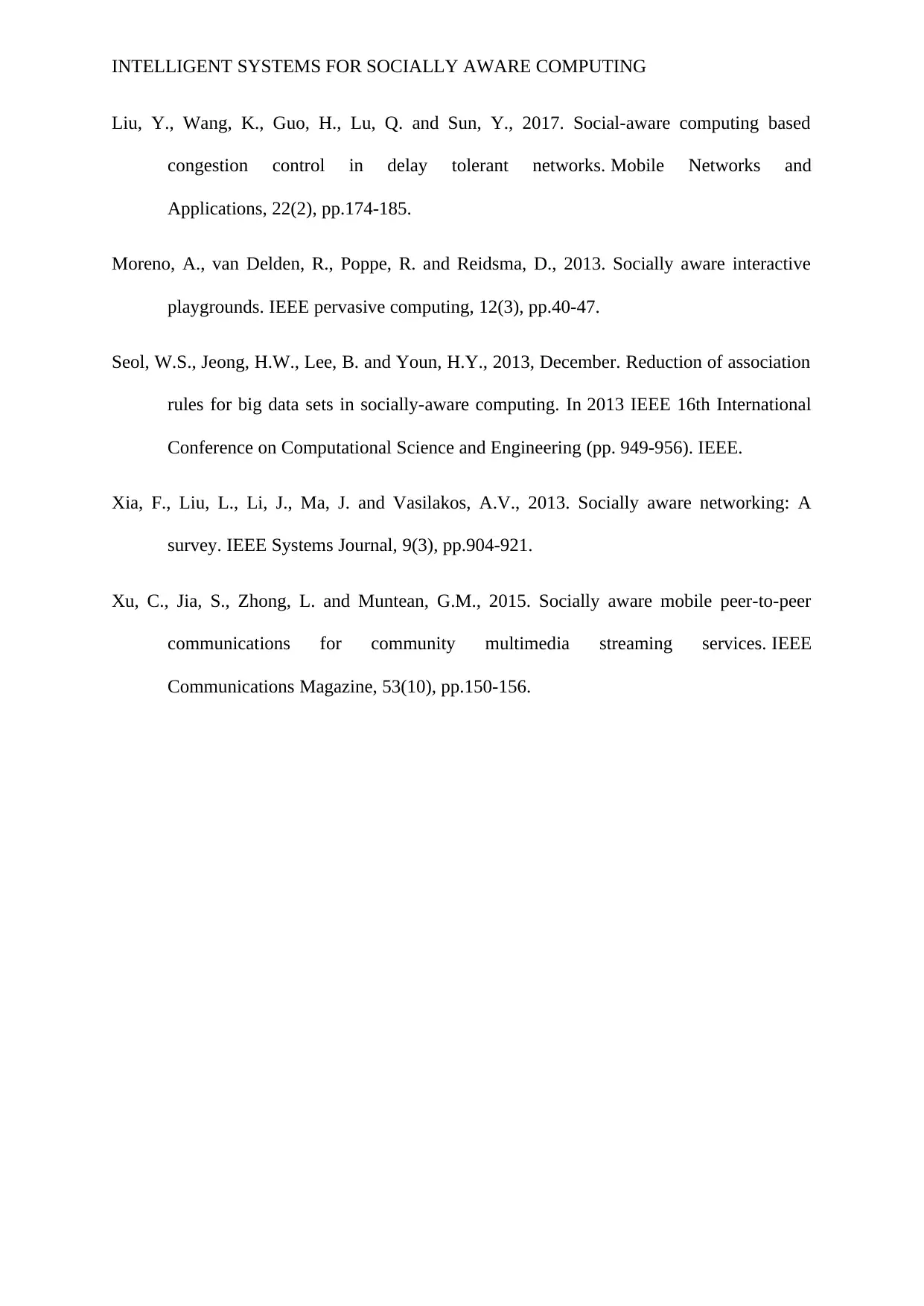
INTELLIGENT SYSTEMS FOR SOCIALLY AWARE COMPUTING
Liu, Y., Wang, K., Guo, H., Lu, Q. and Sun, Y., 2017. Social-aware computing based
congestion control in delay tolerant networks. Mobile Networks and
Applications, 22(2), pp.174-185.
Moreno, A., van Delden, R., Poppe, R. and Reidsma, D., 2013. Socially aware interactive
playgrounds. IEEE pervasive computing, 12(3), pp.40-47.
Seol, W.S., Jeong, H.W., Lee, B. and Youn, H.Y., 2013, December. Reduction of association
rules for big data sets in socially-aware computing. In 2013 IEEE 16th International
Conference on Computational Science and Engineering (pp. 949-956). IEEE.
Xia, F., Liu, L., Li, J., Ma, J. and Vasilakos, A.V., 2013. Socially aware networking: A
survey. IEEE Systems Journal, 9(3), pp.904-921.
Xu, C., Jia, S., Zhong, L. and Muntean, G.M., 2015. Socially aware mobile peer-to-peer
communications for community multimedia streaming services. IEEE
Communications Magazine, 53(10), pp.150-156.
Liu, Y., Wang, K., Guo, H., Lu, Q. and Sun, Y., 2017. Social-aware computing based
congestion control in delay tolerant networks. Mobile Networks and
Applications, 22(2), pp.174-185.
Moreno, A., van Delden, R., Poppe, R. and Reidsma, D., 2013. Socially aware interactive
playgrounds. IEEE pervasive computing, 12(3), pp.40-47.
Seol, W.S., Jeong, H.W., Lee, B. and Youn, H.Y., 2013, December. Reduction of association
rules for big data sets in socially-aware computing. In 2013 IEEE 16th International
Conference on Computational Science and Engineering (pp. 949-956). IEEE.
Xia, F., Liu, L., Li, J., Ma, J. and Vasilakos, A.V., 2013. Socially aware networking: A
survey. IEEE Systems Journal, 9(3), pp.904-921.
Xu, C., Jia, S., Zhong, L. and Muntean, G.M., 2015. Socially aware mobile peer-to-peer
communications for community multimedia streaming services. IEEE
Communications Magazine, 53(10), pp.150-156.
1 out of 11
Related Documents
Your All-in-One AI-Powered Toolkit for Academic Success.
+13062052269
info@desklib.com
Available 24*7 on WhatsApp / Email
![[object Object]](/_next/static/media/star-bottom.7253800d.svg)
Unlock your academic potential
Copyright © 2020–2025 A2Z Services. All Rights Reserved. Developed and managed by ZUCOL.




